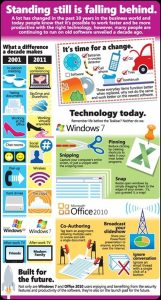 Here’s a blast from the past, when I predicting the average PC of 2012 back in 2008… and the PC of 2008 back in 2003:
Here’s a blast from the past, when I predicting the average PC of 2012 back in 2008… and the PC of 2008 back in 2003:
Way back in 2003, I worked in the Windows Hardware group, and was asked to present at an industry conference about “the PC of tomorrow”. Looking at what we had shown off that year at our Windows Hardware Engineering Conference (WinHEC), I suggested…
“the machine of PC of 2008 would be a multi-processor, 8GB machine with a 200GB HDD, DVD-multi optical and integrated web cam and telephony for under a grand (US$).”
In the summer of 2008 I purchased something quite close to that, as I noted here:
“… in our house is the new HP TouchSmart IQ506 which is quite nice, has very good specs and can be found at a broad range of retail and etail stores. With an Intel Core 2 Duo, 4GB of memory, 500 GB, a 22 inch touch screen, TV tuner and more…”
The configuration cost me about $1,100, which I noted was considerably less expensive than a similarly configured iMac 20-inch at the time (2008 SRP of $1,749.00 with 4GB or memory and 500GB HDD).
I further prognosticated in 2008…
“… by the time our eldest makes it into senior high school [2012], he’ll be taking a light and sleek slimline, multicore notebook with slot-loading DVD, wide screen display, 16GB or memory and a 256GB SSD drive… all for under $1,000.
“But… his main device will be a phone.”
So let’s take a look at what you get today for about $1,000:
Yesterday I purchased a slim Samsung Series 9 notebook PC with an Intel Core i5-2467M 1.60 GHz running Windows 7 Home Premium, 13.3 inch active matrix TFT colour LCD, 4 GB of memory, 128 GB SSD, 1.3 MP HD webcam, premium audio, USB 3.0 ports, Micro HDMI, Ethernet (10/100/1000), seven hours of battery life, 802.11b/g/n, Bluetooth, under three pounds.
Oh, and far less than the $1,000 targeted, including tax.
Or for just under $1,000 (it was on sale 😉 was the Samsung Series 7 slate PC running Windows 7, with an Intel Core i5-2467M processor, 4 GB of memory and a 128GB SSD on a 11.6-inch, multi-touch screen, dual webcams (2.0 MP front, 3.0 MP rear HD cameras), USB 2.0, Micro HDMI, MicroSD – and under two pounds.
Interesting.
What Tom Phillips said then easily resonates today:
“It is our hope that together with the industry we can deliver on the challenge of true system development and deliver what our customers desire – compelling, innovative experiences that improve the way they live, work and are entertained. And as a result, people will get more value out of their PCs.”
My personal guess is that a year from now we’ll see similar sleek and slim multicore notebook offerings with up to 8GB of memory and a 256GB SSD drive for close to $1,000. (Standard disclaimer applies, please don’t attribute this as an official view of anything save a parent planning his back-to-school budget. 😉
The same will go for power all-in-one desktops, just as I noted recently: I purchased a great new Sony VAIO AIO for under $1,000 just before the holidays, complete with 4GB of memory, a 1TB HDD and touch input. By next year, double the memory and the size of the HDD.
But what about the time our oldest is ready for college?
More on that tomorrow: I have to head off and get this boy of the future (and his younger brother, class of 2019) ready for bed.
Tags: Windows, Windows 7, Microsoft.
Also available via http://bit.ly/zWZlAl
